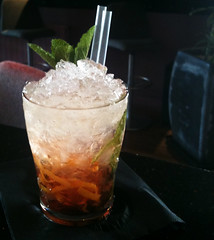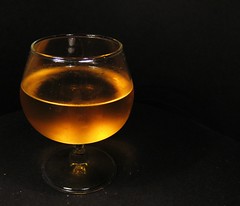Mezcal's global village
"You have to remember," says Ron Cooper, "in 1995, there were three liquor companies on the Internet." It goes some way to explaining why he gives his web address as mezcal.com. But we're not here to talk about registering domains in the pre-Bubble era. Ron's been importing a range of single village mezcals since 1995 and they're starting to pop up in the UK. The Del Maguey range now includes eight mezcals, each made in a distinctive, traditional way by the local palenqueros. After a good dozen years of growing, agave - or maguey, as they're known in Oaxaca - plants are harvested and stripped of their leaves. The pinas (hearts) are then roasted in a conical pit over three to five days. Fermentation is left to wild yeasts before the distillation process that varies from village to village. The mezcal made in Chichicapa is run twice through a copper pot still, while in Santa Catarina Minas, the Minero comes out of a clay pot still. It's not only the type of still that changes - Del Maguey's Pechuga is distilled with almonds, fruit and a whole chicken in the still.
Watch What creates flavors in Mezcal in Lifestyle | View More Free Videos Online at Veoh.com
Not all of the range is as unconventional as the Pechuga. The latest addition is Del Maguey Vida. It's based on San Luis del Rio, one of Del Maguey's first single village mezcals, but it's distilled to a slightly friendlier 42%ABV - all of the Del Maguey mezcals are distilled at proof rather than being diluted to bottling strength - and they cut the distillate nearer the tails than the heads. It's reckoned to be a great mezcal for cocktails, which led to some great drinks from some of Edinburgh's best bartenders.
There was a rare bottle of Del Maguey Chichicapa from the first batch imported the US back in the 90s, and aged for 94 days in a Californian wine barrel up for grabs and in the end, it went to Jamie McDonald from the Raconteur for his twist on a Blue Blazer. Second place went to the West Room's Andrew Kearns with a straight-up sour with sage and rhubarb jam while third place was shared between Tonic's Tom Hodgkiss and, uh, me.

Todo Bien Tambien
50ml Del Maguey Vida
15ml Campari
1 barspoon agave nectar
8 mint leaves
the zest of one lemon, in thin strips
Combine the agave nectar, mint and lemon zest strips in the base of a glass with some crushed ice. Fill with crushed ice and add the Campari and mezcal. Mix well with a barspoon. Garnish with a mint sprig wrapped in a lemon zest twist.
***
There's often a lot of talk about filtration and purity and technology when it comes to discussing spirits, so it's refreshing to come across a series of products that are so focused on traditional methods of production. There's a tangible difference between the various liquids and it all comes from the particular ways that the palenqueros turn two things - maguey and water - into mezcal. There's a reward for this approach, too - Del Maguey Tobala (made from wild maguey plants; it takes a month to collect enough) was named as a semifinalist in the Tequila, Mezcal & Agave-based category at the 2010 Ultimate Spirits Challenge in New York.

